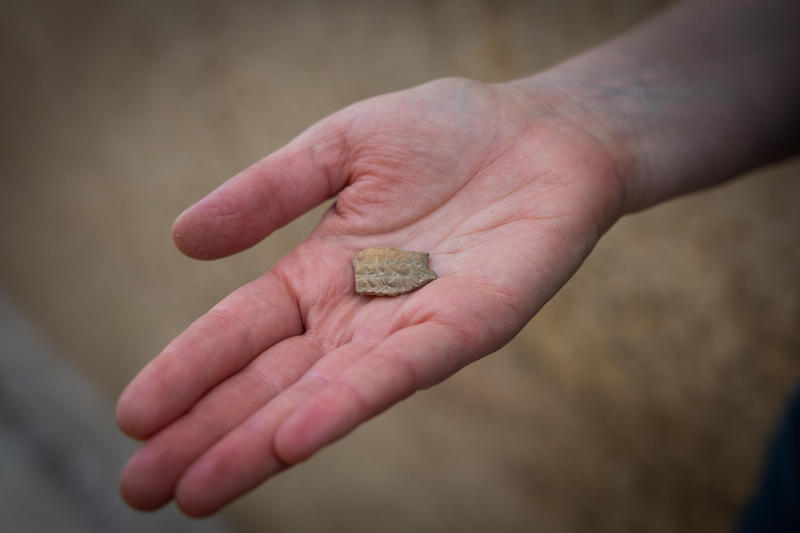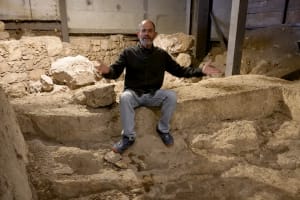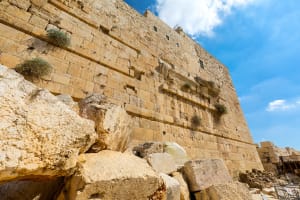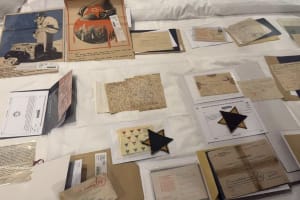Rare First Temple-era Assyrian inscription found in Jerusalem confirms connection with ancient Judah
Small piece of pottery provides more proof of biblical accounts

Historical evidence showing communication between the Assyrian Empire and the king of Judah has been discovered next to the Western Wall during an Israel Antiquities Authority (IAA) excavation taking place in cooperation with the City of David Foundation.
The whole land of Israel is a bit like a giant time capsule, with treasures buried underground from the past that transport the finders back to bygone eras. The information we gain from archeological discoveries gives a great deal of insight into Israel’s history, often proving provocative and surprising.
The small pottery shard, measuring just 2.5 centimeters, bearing a cuneiform inscription in the Akkadian language was discovered during the IAA excavation and deciphered by Dr. Filip Vukosavović and Dr. Anat Cohen-Weinberger together with Dr. Peter Zilberg of Bar-Ilan University. According to the Assyriologists, the words form a complaint about a delayed payment expected by the Assyrian Empire from the king of Judah.
Vukosavović and Cohen-Weinberger revealed that the fragment of the inscription was part of an inscribed royal sealing – a seal impression for a letter or an official dispatch on behalf of the Assyrian royal court.
“Bullae or sealings of this type bore an impression that was sometimes accompanied by a short inscription in Assyrian cuneiform script noting the dispatch’s contents or its destination. These differ in size and shape from the local Judahite impressions,” they explained.
The rare historical evidence of the link between the two kingdoms could possibly indicate a deliberate tax revolt, such as King Hezekiah’s rebellion against Sennacherib, King of Assyria described in 2 Kings 18 and 19. According to 2 Kings 18:14, Hezekiah was required to give 300 talents of silver and 30 talents of gold, with a talent being approximately 30 kilograms (65 pounds).
The inscription specifies a due date – the first of the month of Av, in a calendar shared between Mesopotamia and Judah. It also mentions “one who holds the reins,” referring to a chariot officer or person of high rank responsible for conveying official messages for the royal house. Such a figure is well-known from Assyrian administration archives.
The dating of the pottery shard suggests that the recipient would either be King Hezekiah, Manasseh, or possibly Josiah, all of whom reigned in the period during which Judah was a vassal kingdom of Assyria. The shard itself originated in Assyria, possibly Nineveh, Ashur, or Nimrud/Kalḫu.
As Dr. Anat Cohen-Weinberger of the IAA explained, that analysis shows it had not come from Jerusalem:
“Petrographic analysis of the fragment's composition revealed that the material from which it was made is entirely different from the local raw materials typically used to produce pottery, bullae, and clay documents in Jerusalem and the southern Levant. Moreover, the bulla’s mineral composition generally corresponds to the geology of the Tigris Basin region, where the central cities of the Assyrian kingdom were located, such as Nineveh, Ashur, or Nimrud/Kalḫu. A chemical analysis of the bulla's composition is currently being conducted in collaboration with Dr. Yehudit Harlavan of the Geological Survey of Israel to precisely determine its provenance.”
“While we cannot determine the background for this demand, whether it stemmed from a mere technical delay or was taken as a deliberate step with political significance, the very existence of such an official appeal would seemingly attest to a certain point of friction between Judah and the imperial government,” according to the researchers, who pointed to a verse in 2 Kings 18: “And the Lord was with him; wherever he went out, he prospered. He rebelled against the king of Assyria and would not serve him" (2 Kings 18:7).
Similarly, the complaint of rebellion is seen later in the same chapter: “And the Rabshakeh said to them, “Say to Hezekiah, ‘Thus says the great king, the king of Assyria: On what do you rest this trust of yours? Do you think that mere words are strategy and power for war? In whom do you now trust, that you have rebelled against me?” (2 Kings 18:19-20).
Moriah Cohen, who works at the “Archaeological Experience” in Emek Tzurim, shared her excitement at the discovery: “I was sifting through the dirt and suddenly noticed a sherd with a strange decoration. Examining it closely, it looked to me to be cuneiform, but that seemed totally unreasonable. Even though so many fascinating finds have been discovered here over the years, we've never, ever found anything like this. I examined it yet again. After decidedly determining that this was no decoration, but really was cuneiform, I screamed out of excitement. Everyone aced to gather around me and I phoned Ayala, the excavation director, who was thrilled. For me personally, the thought that after 2,700 years, I am the first person to actually touch this pottery with my hands is a very exciting thought. This is a once-in-a-lifetime find.”
According to Dr. Ayala Zilberstein, Excavation Director on behalf of the IAA, “The inscription provides direct evidence of official correspondence between the Assyrian Empire and the Kingdom of Judah. The discovery strengthens our understanding of the depth of the Assyrian presence in Jerusalem, and the extent of its influence on and involvement in the conduct of the affairs of the Judean kingdom. In addition, it expands knowledge about the status of the new neighborhood that developed at that time on the slopes of the hill to the west of the Temple. It appears that this area served as a focus for the activities of high-ranking ministers and persons.”

The rare Assyrian inscription is the first of its kind to be found in Jerusalem. It will be presented to the public for the first time this Thursday, Oct. 23, at the New Discoveries in Jerusalem and Environs Conference by the IAA, the Hebrew University of Jerusalem, and Tel Aviv University, at the Jay and Jeanie Schottenstein National Campus for the Archaeology of the Land of Israel.
The Assyriologists add, “This is a small fragment of great significance. The find opens a window into understanding the political and administrative ties between Judah and Assyria. It is the very first evidence of its kind of the official, and perhaps even tense, communication that took place between Jerusalem and the world’s most powerful superpower during the period we are discussing.”
Israeli Minister of Heritage, Rabbi Amichai Eliyahu, agreed, “The discovery of the Assyrian inscription from the First Temple period in the very heart of Jerusalem is impressive evidence of the city's status as the capital of the Kingdom of Judah some 2,700 years ago, and of the depth of its ties with the Assyrian Empire just as described in the Bible. This rare discovery illustrates, once again, our deep roots in Jerusalem, which is the spiritual and national center of the Jewish people.”

Is All Israel News’ faithful reporting important to you? Be part of it—help us continue by becoming a $5/month supporting partner.

Jo Elizabeth has a great interest in politics and cultural developments, studying Social Policy for her first degree and gaining a Masters in Jewish Philosophy from Haifa University, but she loves to write about the Bible and its primary subject, the God of Israel. As a writer, Jo spends her time between the UK and Jerusalem, Israel.
You might also like to read this:

















